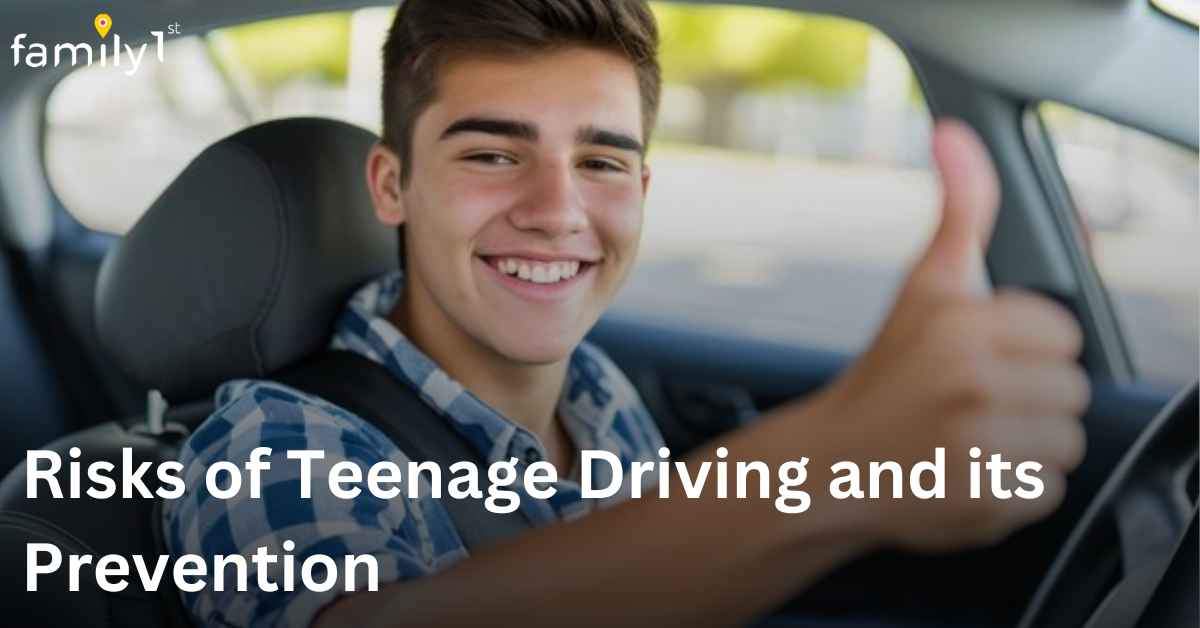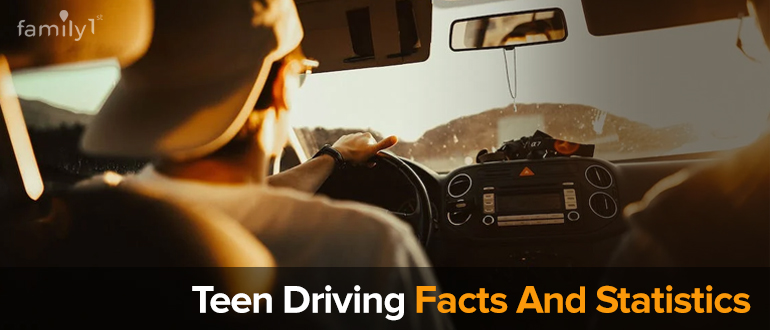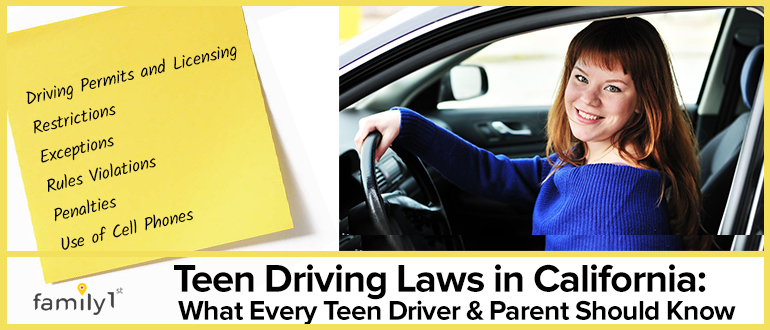Key Takeaways
- Teenage driving is risky due to inexperience, distractions, reckless behavior, and impaired driving, increasing the chances of accidents.
- Preventing teen driving accidents requires graduated licensing, parental rules, defensive driving education, and technology for monitoring.
- Limiting nighttime driving, enforcing a zero-tolerance DUI policy, and promoting seat belt use significantly reduce crash risks.
- Family1st GPS Tracker enhances teen driving safety with real-time tracking, geo-fencing, and a user-friendly app for monitoring driving habits.
Driving is an important milestone in a teenager’s life, providing freedom and responsibility. However, it also comes with serious risks that can lead to accidents, injuries, or even death if not handled carefully.
Teen drivers often face challenges like inexperience, distractions, and reckless behavior, which increase the chances of crashes. Understanding these risks and taking the right preventive measures can help make teenage driving safer for everyone.
Table of Contents
Why Is Teenage Driving So Risky?
Teenagers are far more likely to be involved in car accidents than older, more experienced drivers. This is because they often face challenges that make driving more dangerous. Let’s take a closer look at the biggest risks teen drivers face.
Lack of Experience
New drivers simply don’t have enough time behind the wheel to handle every situation confidently. They struggle with judging distances, adjusting speeds, and making quick decisions, which can lead to serious mistakes.
Example: A teen making a left turn at an intersection may misjudge the speed of an oncoming car, leading to a crash.
Distracted Driving
Teens often get distracted while driving, which makes them much more likely to crash. Some of the biggest distractions include:
- Phones – Texting, calling, or scrolling through social media takes their eyes off the road.
- Passengers – Friends in the car can be a major distraction, causing them to lose focus.
- Music and GPS – Changing songs or checking directions can take their attention away from driving.
Fact: According to the CDC, teen drivers have the highest percentage of fatal crashes caused by distractions.
Speeding and Reckless Driving
Many teenagers enjoy the thrill of driving fast, but they don’t always understand how dangerous it is. They tend to overestimate their ability to control the car and underestimate the risks of speeding.
Example: A teen racing friends on the highway could lose control, causing a serious accident.
Driving Under the Influence (DUI)
Even though there are strict laws against drinking and driving, some teens still take the risk. Alcohol and drugs affect judgment, slow reaction times, and make it harder to control the vehicle.
Fact: According to the National Highway Traffic Safety Administration (NHTSA), 24 percent of fatal teen crashes involve alcohol.
Nighttime Driving Risks
Driving at night is much more challenging, especially for inexperienced drivers. Poor visibility and fatigue make accidents more likely, and many teen crashes happen between 9 PM and 6 AM.
Example: A teen driving home from a late-night party might feel drowsy, slowing their reaction time and increasing the risk of an accident.
Not Wearing Seat Belts
Many teen drivers and passengers don’t wear seat belts, which increases the risk of serious injury or death in a crash.
Fact: In 2021, 56 percent of teen drivers killed in accidents were not wearing seat belts, according to the Insurance Institute for Highway Safety (IIHS).
Teen driving comes with serious risks, but awareness and responsible habits can make a big difference. Understanding these dangers is the first step toward making the roads safer for everyone.
How to Prevent Teenage Driving Accidents
Teen driving comes with serious risks, but there are effective ways to make it safer. Parents, schools, and lawmakers all play a role in protecting teen drivers and reducing accidents. Here are some practical steps to help keep teenagers safe on the road.
Graduated Driver Licensing (GDL) Programs
Teen drivers need time and practice to develop safe driving skills. GDL programs help by introducing driving privileges in stages, allowing teens to gain experience under lower-risk conditions. These programs usually have three steps:
- Learner’s Permit – Teens can only drive with a licensed adult and must follow strict rules like no night driving.
- Intermediate License – Teens can drive alone but with restrictions, such as no passengers under a certain age and a curfew for night driving.
- Full License – Teens get full driving privileges after proving they can drive safely.
Studies show that GDL programs have reduced teen crashes by 20% to 40%, making them one of the best ways to improve teen driver safety.
Setting Clear Rules at Home
Parents have a huge influence on their teen’s driving habits. Setting clear rules can help prevent dangerous behaviors. Some key rules to enforce include:
- No texting or calling while driving.
- No speeding, no matter the situation.
- No more than one passenger at a time.
- No driving after 10 PM unless absolutely necessary.
- Always wear a seat belt, no exceptions.
Some parents even create a parent-teen driving agreement to set expectations and consequences. The more consistent the rules, the safer the teen will be.
Teaching Defensive Driving
Defensive driving means staying aware of potential dangers and knowing how to react. Teens should be taught how to:
- Keep a safe distance from other cars.
- Watch for aggressive drivers and avoid them.
- Stay focused and avoid unnecessary risks.
- Adjust speed and braking based on weather and road conditions.
Example: A defensive driver slows down when approaching an intersection, even if they have the green light, just in case another car runs a red light.
Teaching these habits early on can prevent many accidents.
Using Technology to Monitor Driving
Technology can help parents keep an eye on their teen’s driving habits. There are different tools available, such as:
- GPS tracking apps – Show real-time location and speed.
- In-car monitoring systems – Detect sudden braking, sharp turns, or phone use while driving.
- Smartphone apps – Some apps block notifications and texts when the car is moving.
Educating Teens About Distracted Driving
Many teens don’t realize how dangerous distractions can be. They need to be reminded that:
- Texting while driving is deadly. Just five seconds of looking at a phone while going 55 mph is like driving the length of a football field blindfolded.
- Other distractions matter too. Eating, changing the music, or talking to passengers can take attention away from the road.
Encouraging teens to use “Do Not Disturb” mode on their phones while driving can help prevent distractions. Schools should also reinforce the importance of keeping eyes on the road at all times.
Limiting Nighttime Driving
Driving at night is more dangerous, especially for inexperienced drivers. Visibility is lower, and fatigue can slow reaction times. Many states have night driving restrictions for new drivers, and parents should follow the same rules.
Research shows that limiting teen driving at night has reduced fatal crashes by 50% in some areas. If a teen must drive at night, it’s best to ensure they are well-rested and take safer routes.
Enforcing a Zero-Tolerance Policy for DUI
Drinking and driving is never acceptable, but some teens still take the risk. Parents and schools need to stress the dangers of DUI and provide alternatives, such as:
- Educating teens about the legal consequences of DUI.
- Encouraging them to call for a ride if they ever feel unsafe driving.
- Hosting safe, alcohol-free gatherings.
Some parents use a “no-questions-asked” policy, meaning their teen can call for a ride home with no immediate consequences. This helps prevent teens from making a deadly decision.
Promoting Seat Belt Use
Wearing a seat belt is one of the simplest and most effective ways to reduce injury in a crash. Yet, many teens still neglect to buckle up.
Parents and teachers should emphasize seat belt use by:
- Always wearing their own seat belts as an example.
- Making it a rule that everyone in the car must buckle up before the car moves.
- Sharing real-life stories of how seat belts have saved lives.
Campaigns like “Click It or Ticket” have helped increase seat belt use, but it starts with enforcing the habit at home.
How Family1st Product Your Teen?
![]()
Family1st GPS Tracker helps protect your teen by providing real-time tracking, allowing parents to monitor their teen’s location at all times. With the geo-fencing feature, parents can set safe zones and receive instant alerts if their teen enters or exits restricted areas, reducing the risk of driving in unsafe locations.
This GPS tracker also enhances teen driving safety with long battery life, ensuring continuous monitoring without frequent recharging. The user-friendly mobile app makes it easy for parents to check driving routes, helping to track habits and prevent reckless driving before accidents happen.
Conclusion
Teen driving comes with serious risks, but with the right precautions, accidents can be prevented. By focusing on education, enforcing rules, and using technology, parents can help their teens develop safer driving habits.
Encouraging responsible driving, limiting distractions, and promoting seat belt use can make a big difference in reducing crashes. With tools like the Family1st GPS Tracker, parents can stay connected and ensure their teen’s safety on the road.











Next
Previous